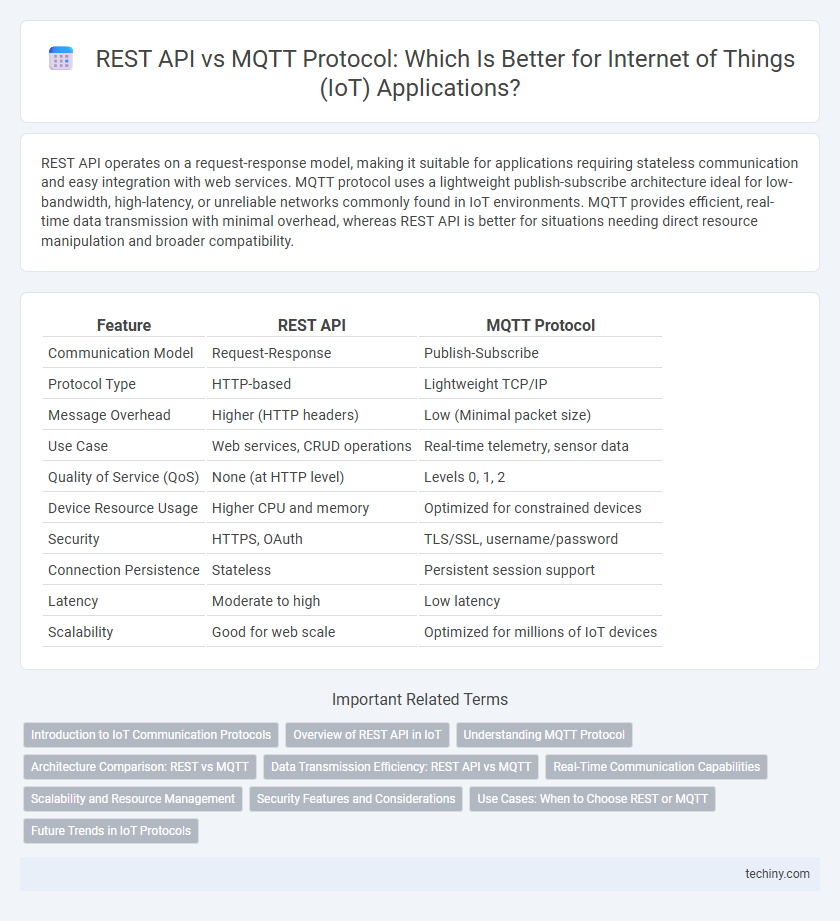REST API operates on a request-response model, making it suitable for applications requiring stateless communication and easy integration with web services. MQTT protocol uses a lightweight publish-subscribe architecture ideal for low-bandwidth, high-latency, or unreliable networks commonly found in IoT environments. MQTT provides efficient, real-time data transmission with minimal overhead, whereas REST API is better for situations needing direct resource manipulation and broader compatibility.
Table of Comparison
| Feature | REST API | MQTT Protocol |
|---|---|---|
| Communication Model | Request-Response | Publish-Subscribe |
| Protocol Type | HTTP-based | Lightweight TCP/IP |
| Message Overhead | Higher (HTTP headers) | Low (Minimal packet size) |
| Use Case | Web services, CRUD operations | Real-time telemetry, sensor data |
| Quality of Service (QoS) | None (at HTTP level) | Levels 0, 1, 2 |
| Device Resource Usage | Higher CPU and memory | Optimized for constrained devices |
| Security | HTTPS, OAuth | TLS/SSL, username/password |
| Connection Persistence | Stateless | Persistent session support |
| Latency | Moderate to high | Low latency |
| Scalability | Good for web scale | Optimized for millions of IoT devices |
Introduction to IoT Communication Protocols
REST API and MQTT are essential IoT communication protocols enabling data exchange between devices and applications. REST API uses HTTP for stateless, request-response communication suited for web services, while MQTT operates on a lightweight, publish-subscribe model optimized for low-bandwidth, high-latency environments. Choosing between REST API and MQTT depends on specific IoT requirements such as network constraints, real-time data needs, and device resource limitations.
Overview of REST API in IoT
REST API in IoT enables seamless communication between devices and cloud services using stateless HTTP protocols, making it ideal for resource-constrained environments. It supports CRUD (Create, Read, Update, Delete) operations through standardized methods like GET, POST, PUT, and DELETE, facilitating easy integration and interoperability across diverse IoT platforms. REST's simplicity, scalability, and wide adoption enhance device management, data retrieval, and control in IoT ecosystems.
Understanding MQTT Protocol
MQTT protocol is a lightweight messaging protocol designed for constrained devices and low-bandwidth, high-latency networks commonly used in Internet of Things (IoT) applications. It operates on a publish-subscribe model, enabling efficient real-time data exchange between sensors, gateways, and cloud services. MQTT's minimal packet overhead and support for persistent sessions make it ideal for reliable communication in IoT ecosystems compared to REST API's stateless request-response pattern.
Architecture Comparison: REST vs MQTT
REST API architecture follows a stateless, client-server model using HTTP methods, making it suitable for request-response communication with resource-oriented endpoints. MQTT architecture employs a lightweight publish-subscribe model based on topics, optimized for low-bandwidth, high-latency, or unreliable networks in IoT environments. REST relies on direct interactions between clients and servers, while MQTT uses a central broker to manage message distribution, enhancing scalability and decoupling communication.
Data Transmission Efficiency: REST API vs MQTT
MQTT protocol outperforms REST API in data transmission efficiency due to its lightweight publish-subscribe architecture, minimizing overhead and enabling faster message delivery in IoT environments. REST API relies on HTTP, which involves larger packet sizes and higher latency, making it less suitable for real-time, low-bandwidth IoT applications. MQTT's persistent session and binary payload format optimize network resource usage, thereby enhancing overall system responsiveness and scalability.
Real-Time Communication Capabilities
MQTT protocol excels in real-time communication for Internet of Things (IoT) applications by providing lightweight, low-latency messaging suitable for constrained devices and unreliable networks. REST API operates on a request-response model that introduces higher latency and overhead, making it less ideal for time-sensitive IoT data transmission. MQTT's publish-subscribe architecture ensures efficient, instantaneous updates, enhancing real-time data exchange essential for critical IoT systems.
Scalability and Resource Management
REST API relies on HTTP, making it less efficient for large-scale IoT deployments due to higher bandwidth and latency, whereas MQTT is designed for minimal network bandwidth and low power consumption, enabling better scalability in constrained environments. MQTT's lightweight publish-subscribe architecture optimizes resource management by reducing communication overhead and supporting numerous devices simultaneously, contrasting with REST's request-response model that can strain processing resources. Efficient scalability in IoT ecosystems is achieved through MQTT's persistent session and message queuing features, ensuring reliable communication with optimized resource usage across extensive device networks.
Security Features and Considerations
REST API relies on HTTPS for secure communication, providing robust encryption and authentication mechanisms such as OAuth, which protect data integrity and privacy in IoT applications. MQTT employs lightweight security features, including TLS/SSL for encrypted connections and optional username/password authentication, tailored for low-bandwidth, resource-constrained IoT devices. Security considerations in MQTT also involve managing broker access control and ensuring client-side certificate validation to prevent unauthorized data interception and device spoofing.
Use Cases: When to Choose REST or MQTT
REST API is ideal for request-response scenarios requiring stateless communication and easy integration with web services, such as device management or configuration in IoT systems. MQTT protocol excels in low-bandwidth, high-latency, or unreliable network environments, making it suitable for real-time telemetry, sensor data streaming, and remote monitoring applications. Choosing REST suits applications prioritizing interoperability and simplicity, while MQTT is preferable for scenarios demanding efficient, reliable, and scalable message delivery.
Future Trends in IoT Protocols
REST API remains widely used for IoT due to its simplicity and compatibility with web technologies, while MQTT is favored for lightweight, real-time messaging in constrained environments. Emerging trends indicate growing adoption of hybrid protocols combining REST's scalability with MQTT's efficiency to support massive IoT deployments. Future IoT protocols emphasize enhanced security, low latency, and interoperability across diverse devices to meet the demands of smart cities, industry 4.0, and edge computing.
REST API vs MQTT protocol Infographic

 techiny.com
techiny.com